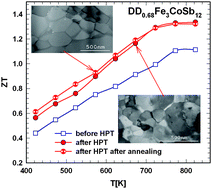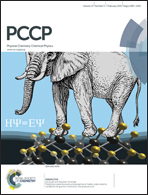Changes in microstructure and physical properties of skutterudites after severe plastic deformation
Abstract
The best p-type skutterudites with ZT > 1.1 so far are didymium (DD) filled, Fe/Co substituted, Sb-based skutterudites. DD0.68Fe3CoSb12 was prepared using an annealing–reacting–melting–quenching technique followed by ball milling and hot pressing. After severe plastic deformation via high-pressure torsion (HPT), no phase changes but particular structural variations were achieved, leading to modified transport properties with higher ZT values. Although after measurement-induced heating some of the HPT induced defects were annealed out, a still attractive ZT-value was preserved. In this paper we focus on explanations for these changes via TEM investigations, Raman spectroscopy and texture measurements. The grain sizes and dislocation densities, evaluated from TEM images, showed that (i) the majority of cracks generated during high-pressure torsion are healed during annealing, leaving only small pores, that (ii) the grains have grown, and that (iii) the dislocation density is decreased. While Raman spectra indicate that after HPT processing and annealing the vibration modes related to the shorter Sb–Sb bonds in the Sb4 rings are more affected than those related to the longer Sb–Sb bonds, almost no visible changes were observed in the pole intensity and/or orientation.


 Please wait while we load your content...
Please wait while we load your content...